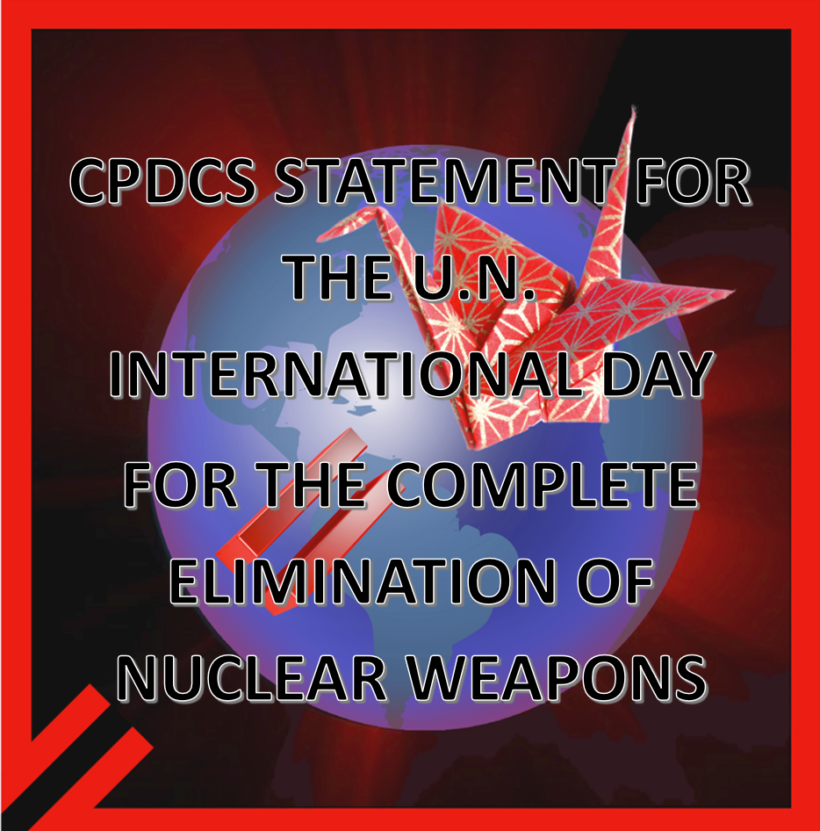The establishment of the United Nations International Day for the Complete Elimination of Nuclear Weapons reflects humanity’s recognition of the continuing existential threat to human survival and civilization posed by nuclear weapons. As the Hibakusha, Japanese A- and H- Bomb survivors teach us from their terrorized and excruciating experiences, “Human beings and nuclear weapons cannot coexist.” It is also true that given the dictates of nuclear command and control, nuclear weapons and democracy cannot coexist.
Today the Treaty on Prohibition of Nuclear Weapons and continuing popular demands for nuclear disarmament serve as the most forceful, but not sufficient counterweight to continuing preparations by all nine nuclear weapons states to wage apocalyptic nuclear war.
In fact, as we see with the Bulletin of the Atomic Scientists’ Doomsday Clock set at 90 seconds to midnight, the danger of nuclear war is far greater today than it was in 2013 when the International Day was established. A senior member of Russia’s national security elite states that this is the most dangerous moment in international relations since the 1962 Cuban Missile Crisis, when President Kennedy’s advisors thought the chances of nuclear war were between a third and a half. That we are alive today is a function of luck and inspired diplomacy, the latter of which is dangerously absent today.
Following a tradition practiced by almost every U.S. president, President Putin and his most senior advisors have threatened the first use of nuclear weapons, this time especially if Moscow’s control of Crimea is threatened. Midst the Ukraine War and growing tensions between the West and Russia, in violation of the Nuclear Nonproliferation Treaty, new generation of U.S. nuclear weapons are being deployed to NATO allies, and Russia is in the process of deploying nuclear weapons to Belarus. In East Asia, the U.S. is again deploying nuclear armed ships to South Korean waters and ports, and tensions over Taiwan were a primary factor in the Biden Administration’s refusal to adopt either a sole use or no first use nuclear doctrine in its National Security Strategy. Planning for use of tactical nuclear weapons in a war for Taiwan is now common in policy circles in Washington, D.C. And the absence of strategic stability and arms control diplomacy between the U.S. and Russia and the U.S. and China greatly increase the dangers that an accident, incident, or miscalculation could trigger disastrous escalation to nuclear war.
All of the nuclear powers are either expanding or “modernizing” their nuclear arsenals. Iran and Japan are near nuclear powers, and South Korea and Saudia Arabia face both domestic and international pressures to equalize what they perceive to be unjust imbalances of nuclear terror.
The International Day for the Total Elimination of Nuclear Weapons provides us with an opportunity to raise the alarm, to emphasize the centrality of Article VI of the Nuclear Nonproliferation Treaty which calls for good faith negotiations for the complete elimination of nuclear weapons. Most importantly, the Day encourages us to increase our commitments, organizing, and advocacy for the nuclear weapons-free world that we and future generations deserve.
The Second Meeting of States Parties of the Treaty on Prohibition of Nuclear Weapons convenes at the U.N. in New York the week of November 27. We hope to see you there, in person or online, for our conferences.
Campaign For Peace, Disarmament & Common Security






